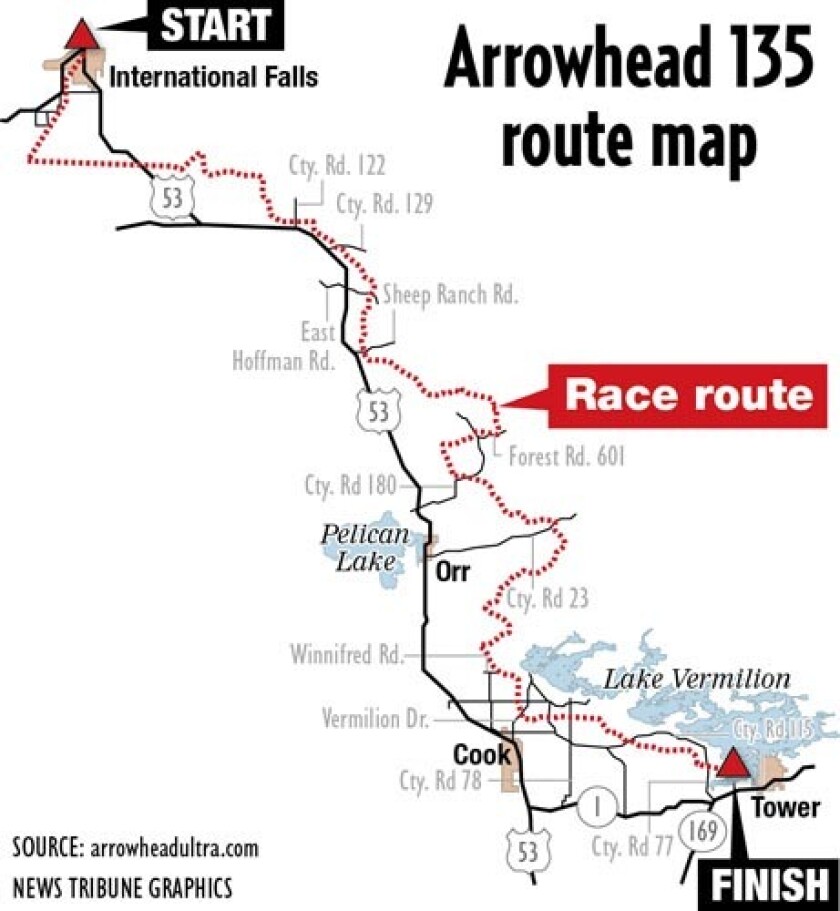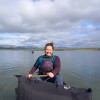DULUTH — After several days of below-zero temperatures, most people are relieved to have moderate temperatures again.
But not Ken Krueger, who, along with his wife, Jackie, serves as race director of the annual Arrowhead 135 race, which begins Monday, Jan. 27, in International Falls. Competitors will traverse 135 miles of snowmobile trails on foot, bike, ski or kicksled to the finish line at Fortune Bay Resort Casino near Tower.
ADVERTISEMENT
“We should have started this week instead of next week,” Krueger said Wednesday.
The coldest temperature recorded the morning of Monday, Jan. 20, was 42 below zero at Kabetogama — the race’s first checkpoint.

Krueger said holding the race in the brutal cold “would have been fantastic.” It’s been held during the polar vortex in 2014 and 2019.
“That’s part of our reputation,” Krueger said. “We have very low finish rates in the cold years, and people want that challenge. They want to brag about it. And unfortunately, we missed it.”

According to the National Weather Service, it will be 20 degrees at the 7 a.m. Monday start in International Falls. The high will be 24 degrees Monday, but temperatures will dip to about 0 degrees overnight.
Racers will likely begin finishing in Tower on Tuesday and must finish by 7 p.m. Wednesday — 60 hours after the start. The high in Tower on Tuesday is expected to be near 16 degrees, falling to about 5 degrees overnight before jumping up to 25 degrees Wednesday.
There have been years where it’s been so cold that racers’ beards, eyelashes and neckwarmers are covered in ice. In those conditions, batteries for headlamps don’t keep their charge and water bottles freeze.
ADVERTISEMENT
A little bit warmer is OK with some racers, like Leah Gruhn, 45, of Duluth, who is set to start her 14th Arrowhead 135. She’s completed 10 of the races and has entered as a cyclist in all but her first, where she competed on cross-country skis until dropping out near the midway point.
She’ll be biking again this year.
“I hope it’s going to be as close to perfect conditions as there could be,” Gruhn said.
Just as long as it doesn’t get too warm. When it’s warm, snow turns into “mashed potatoes consistency,” making it hard for cyclists to control their bikes, Gruhn said.
While racers may be shedding layers this year instead of knocking "snotsicles" from their faces, warmer temperatures bring other challenges.
Michael Koppy, 74, of Hermantown, is set to run his first Arrowhead 135, and if he finishes, he will become the oldest person to finish the race’s “on foot” category.
With warmer temperatures, Koppy said he’ll be trying to avoid getting soaked in sweat.
ADVERTISEMENT
“When you’re working hard, you’ve got to be careful not to sweat and get wet because there’s really no place to dry out if you do,” Koppy said. “And then you’re going to get cold and you’re going to freeze.”
While it’ll be his first Arrowhead 135, he’s no stranger to ultramarathons. He's finished several 200- and 250-mile races.
He is running the Arrowhead 135 and the Western States Endurance Run, a 100-mile ultramarathon in California’s Sierra Nevada Mountains in June, to raise funds for the Duluth Area Family YMCA.

He also holds the fastest-known time for a supported completion of the 310-mile Superior Hiking Trail, which stretches from the Minnesota-Wisconsin border south of Duluth to the U.S.-Canada border. In 2020, at age 69, Koppy finished the route in five days, three hours and 44 minutes, shaving more than a day off the record set a year earlier by a 24-year-old man.
Koppy said ultrarunning allows him to enjoy commanding vistas and views from the trails and just “zone out.”
“You can run 20 miles, and it feels like 10 minutes have gone by,” Koppy said. “You’re so in the here and now, and in life we have so many distractions we don’t get a lot of chance to be that way. You’re doing one simple thing, putting one leg in front of the other continuously and it’s not a very complicated process. Although in some ways, it is.”
But the Arrowhead 135’s winter setting presents new challenges. For one, he’ll be hauling a 55-pound sled he built, full of food, water and gear.
ADVERTISEMENT
Racers can either do the race supported — meaning they can go inside the buildings at the race’s three checkpoints to warm up and accept food and water there — or they can do it unsupported, meaning they must stay outside the entire time, eat only what they pack and drink only what they carry or melt from snow.

The race requires each participant — supported or unsupported — to carry emergency gear like a stove, a bivy sack or tent, a sleeping bag rated to 20 below zero or colder and a firestarter, among other equipment.
They must also carry a satellite tracker (spectators can track racers online) and must have at least one day’s worth of food, or 3,000 calories, on them at all times in case of an emergency.
Gruhn said she buries that food deep into her gear so she isn’t tempted to reach for it during the race.
Besides hauling gear, racers must overcome exhaustion and its bizarre side effects, like hallucinations.
At about 15-20 hours into the race, Gruhn said she’s been so fried that she starts to see things that aren’t there — new cabins built right on the trail, a man in a T-shirt driving a tractor, eagles just sitting there not flying away.
“And then when you get closer you’re like, ‘Oh yeah, it’s another tree with snow on it,’” Gruhn said.
ADVERTISEMENT
But she keeps coming back.
“It feels like a family reunion when you go up because there’s a bunch of people who come from all over the country who you only see once a year,” Gruhn said.

There’s a lot of camaraderie on the trail, too, with racers talking and commiserating with each other as they inch closer to the finish.
“One of the things I appreciate most is just being kind of in this environment where everyone is working so hard, like working the hardest they possibly can, to do their best, and being so encouraging of everyone else around them to do the same,” Gruhn said. “It’s something that’s pretty cool.”
Koppy echoed that.
“You meet total strangers and you might be with them for 10 hours or something and you’ll learn more about that person and share more about yourself than you do any other place. … I love all aspects of that,” Koppy said.
As of Thursday, the race roster shows 191 people registered for the race: 89 on foot, 93 on bikes, eight on skis and one on a kick sled.
ADVERTISEMENT
But this year’s trail conditions and lack of snow may prompt skiers to reconsider. Krueger said he’d be surprised if anyone skis this year.
For a race that prides itself on extreme weather conditions, would there ever be anything that cancels it?
“The only situation I could imagine is a snowstorm so big that we couldn’t get emergency vehicles to get people out,” Krueger said.
Temperature and weather factor into finish rates, averaging about 58%, he said. It’s been as high as 82% and as low as 20%. He expects a finish rate of about 73% this year, based on the forecast conditions.
Gruhn said finishing is never a given. “There’s no such thing as an easy Arrowhead,” she said.
But it won’t be as long as the 1,000-mile Iditarod Trail Invitational in Alaska, which Gruhn biked in 2023 in 21 days.
“Hopefully,” Gruhn said, “this’ll only take me one to two days.”















